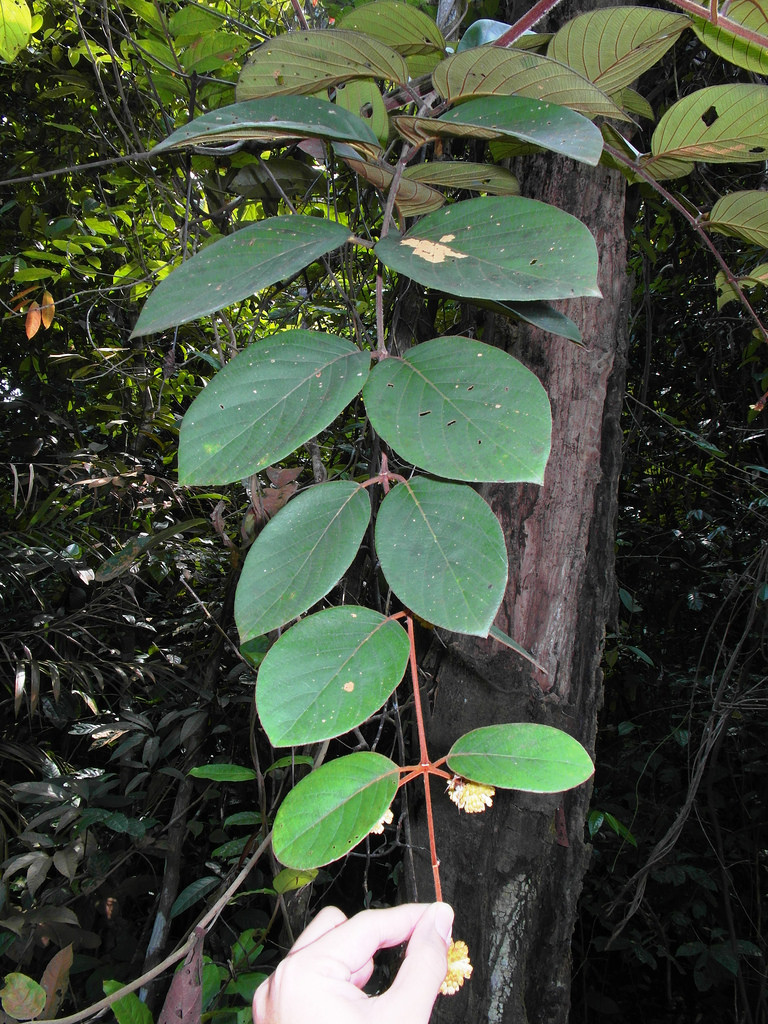Gambier
(Uncaria)

Description
Uncaria is a genus of flowering plants in the family Rubiaceae. It has about 40 species. Their distribution is pantropical, with most species native to tropical Asia, three from Africa and the Mediterranean and two from the neotropics. They are known colloquially as gambier, cat's claw or uña de gato. The latter two names are shared with several other plants. The type species for the genus is Uncaria guianensis. Indonesian Gambier (U. gambir) is a large tropical vine with leaves typical of the genus, being opposite and about 10 cm (3.9 in) long. The South American U. tomentosa is called Uña de Gato. Uncaria sinensis is common in China. Uncaria was named in 1789 by Johann von Schreber in his Genera Plantarum edition 8[a] (not to be confused with books of the same title by Linnaeus, Jussieu, and others). The genus name is derived from the Latin word uncus, meaning "a hook". It refers to the hooks, formed from reduced branches, that Uncaria vines use to cling to other vegetation. Uncaria is a member of the tribe Nauclea, but its position within that tribe remains unresolved. Woody lianas; climbing by hooks formed from reduced, modified branches. Stipules entire or bifid. Inflorescences are compact heads at the ends of horizontal, very reduced branches. Corolla lobes without appendages. Seeds with a long wing at each end, the lower wing deeply bifid. Uses: Cat's claw (U. tomentosa) and the Chinese species are used medicinally. The glycosidic compounds have recognized anti-inflammatory properties, while the alkaloids increase the reactivity of lymphocytes, granting higher response to viral infection. Cat's claw has two varieties depending on whether the alkaloids have four rings or five. The five-ring alkaloid variety is medicinal and is called "savéntaro" by the Asháninka.[citation needed] Diplomat Edmund Roberts noted that upon his visit to China in the 1830s, Chinese were using it for tanning, and noted that the uncaria gambir made "leather porous and rotten." He also noted that Chinese would chew it with areca nut. Gambier (U. gambir), is chewed in Indonesia with areca and betel as well as used for tanning and dyeing. It contains many flavan-3-ols (catechins) which are known to have many medicinal properties and are components of Chinese herbal remedies and certain modern medicines. To make gambier, the leaves are first boiled in water. They absorb it and turn brownish in color. The leaves are then pressed mechanically to squeeze and extract liquid. This liquid is then dried into a semi-solid paste and molded into cubes, which are dried in the sun. Gambier is generally packed in 50 kilograms (110 lb) multi-layered packing (polypropylene bags inside and gunny bags outside). U. rhynchophylla has also been shown to be a powerful MAO-B inhibitor. Research has shown that rhamnose, a deoxy sugar extracted from uncaria plants, can actively rejuvenate skin, making it feel plumper and more elastic
Taxonomic tree:







